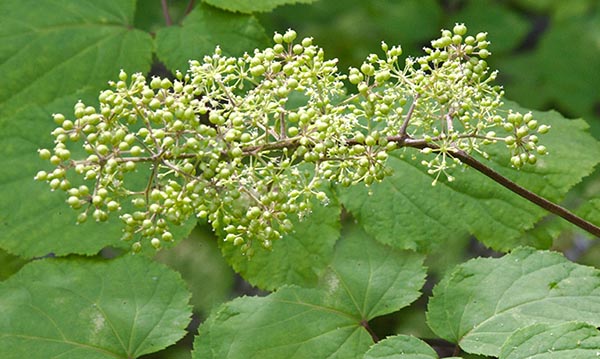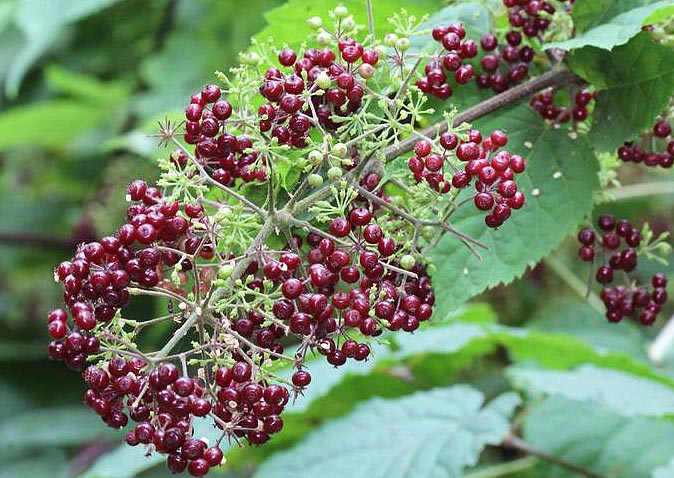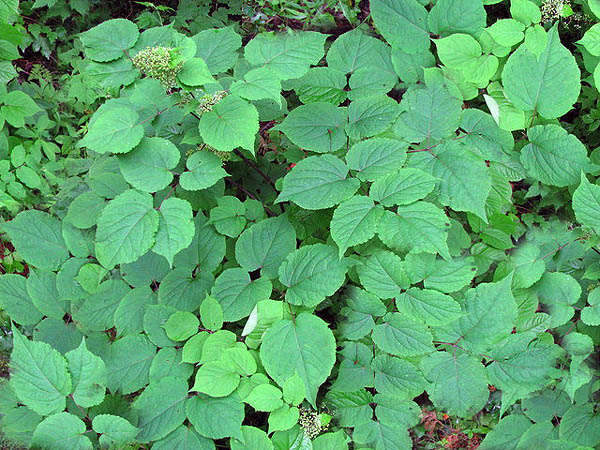A lovely plant for woodland understory or for other shady areas where little else will grow. American spikenard likes shade but needs a rich loamy well drained soil to do well. If given this it will produce some huge leaves, up to 2 feet (61 cm) across and lovely white to cream colored flower spikes, followed by purple berries which ripen just as the leaves are turning a golden yellow to offset the berries. Ideal for woodland settings especially those with water nearby. It does like a moist soil so would need extra water in dry areas. Takes a little effort to start the seeds as they need stratification but once its established it needs no care at all. Simply plant it and leave it. Enjoy the flowers and the fall leaf color. The pollinators love the flowers and the birds enjoy the berries. American spikenard grows some large roots that are very aromatic and used in herbal medicine. Its related to American Ginseng and is recently been attracting attention as an adaptogen which helps to balance the body and help to cope with stress. If you have a woodland and don't know what to do with it, then adding some Spikenard may be just the thing you need. Hardy to zone 3.
Description of American Spikenard (Aralia racemosa).
A large woodland plant that can act more like a shrub but dies down to the ground in winter. The leaves are huge and can reach 2 feet (61 cm) in length and the same in width. Each leaf stem has three main sections (rarely four) These divide again into and have opposite pairs of leaflets along a central stem. Most commonly two pairs of leaflets and a apical one. The leaflets are oval in shape with a pointed tooth at the tip. Each leaflet can be anywhere from 2-6 inches (5-15cm) long and the veins on the underside may have fine hairs. The plant produces relatively few leaves but they can rise to the height of 6 feet (183 cm) in well established mature plants. In late spring early summer flower stalks are produces these come either from the top of the leaf or from the leaf axils. They are composed of a spreading panicle that can reach 12 inches (30 cm) in length and are much branched and made up of individual stalked flowers that have 5 greenish to white triangular petals which are usually folded back against the stem. It's the large white green stamens that reach out that are the most noticeable part of these tiny flowers since each in only about 1/8" (3 mm) across and flowers open at different times, so there is no sudden showiness to the flowers. The fruits that follow are far more noticeable as they mature to a dark purple or reddish brown with each berry being about ¼" (6 mm) in diameter and resemble elderberries when ripe. At the time the berries ripen the leaves begin to turn a golden color giving a showy dramatic contrast. The plant is hardy to zone 3 and is a north American native.
Growing American Spikenard (Aralia racemosa) from Seed.
American Spikenard seeds need stratification before they will germinate. This can either be done naturally by sowing the seeds in the desired location during the fall or early winter period and allowing nature to do the job or it can be done artificially. This can either be by starting in seed trays or pots sown and left outside during the winter or by placing in the refrigerator. See our
stratification instructions to determine which method is best for you.
If you purchase seeds at a time that is unsuitable to grow them, too late in spring or in summer to be sown then keep the in your refrigerator until winter comes around and sow them then. While they can be started and placed in the refrigerator at any time having seeds sprouting out of season usually results in poor plant establishment.
Some sources recommend scarifying the seed first but we have not found that this increase germination rates.
Germination can be spotty so sowing in individual pots or cell pots is suggested so that ungerminated seeds are not disturbed by removal of those that are growing. If all your seeds do not germinate keep the seed tray in a cool place over the summer and leave outside again during the second winter most commonly the rest of the seeds will then germinate.
Once seedlings are growing transfer to individual pots (if not already growing in them) and grow on to at least 6" (15 cm) in height before planting out.
Location and Care of American Spikenard (Aralia racemosa).
Pick your location with care as this plant does not like to be moved much once established. American Spikenard is a shade loving understory plant for woodlands. It is perfect for those who have some trees or woodlands. These plants can brighten the area during the summer months when they flower and provide showy color as the leaves turn golden in fall. Full to partial sun can be tolerated in colder zones 3-5 but not in zones warmer than this. Plant in a full shade environment.
American Spikenard likes rich loamy well drained soil best. It needs a well drained soil but is not fussy about soil type but does prefer a reasonably neutral soil pH - around 6.1 - 7.8. Otherwise and will grow almost anywhere. Due to its large leaf area it does prefer areas that have sufficient rainfall otherwise plant near a water body or give supplemental water during hot dry periods. If the plant is happy with its environment it will often spread to form a colony using its rhizomatous root system. It will also reseed itself slowly over time.
Since plants can grow so large choose companion plants carefully, it will quickly overshadow small delicate plants so using hostas, ferns or spring perennials like winter aconite, foam flower and such like can provide an excellent use of woodland areas.
Plants need to mature before they will flower and fruit this can take between 3-4 years from seed. Choose location carefully as due to the large roots American Spikenard does not take well to being transplanted.
Harvesting American Spikenard (Aralia racemosa).
Roots are used in herbal formulas. Roots need to be harvested from mature plants juvenile roots do not have the same properties so the plant must have flowered and fruited before it can be harvested. Roots can be up to 3' (91 cm) long and about 1" (2.4cm) thick. Dig roots in fall when medicinal compounds are at their highest.
Culinary Uses of American Spikenard (Aralia racemosa).
Many report that the young shoots are edible and can be added to soups and stews. The aromatic roots are the most commonly used either to make root beer as a substitute for sarsaparilla or to spice casseroles and other savory dishes where it has a flavour reminiscent of licorice. Reports on the fruit edibility varies, some say they are great and can be eaten raw as snacks, others claim they are only palatable when cooked. It most likely depends on where the plant is growing as this can have a varying effect on berry sweetness. So try it out and determine which category yours belong to before eating too many. Otherwise use them for jams or jellies. This however can be time consuming since the berries are so small.
Medical uses of American Spikenard (Aralia racemosa).
The plant is related to American ginseng and has in recent years been recognized as an adaptogen helping to balance the body and protect against some stresses. The aromatic roots have a spicy flavor similar to licorice and have been used to treat respiratory ailments including asthma, coughs and other pulmonary diseases. The herb encourages sweating, which can help with detoxification when taken internally and was often used in the treatment of is stimulating and detoxifying and so is used internally in the treatment of rheumatism , gout, syphilis, and other diseases in which it was deemed necessary to "purify the blood. Native Americans made a poultice for treatment of fractures, and other broken bones as well as many skin problems such as eczema, sores, burns, itchy skin, ulcers, swellings and drawing boils. Other tribes used it in a tea to make labor and childbirth swifter and less painful.
Other names.
Life-of-Man plant, Nard, Indian root, petty morel, spice berry, and spignet.
The plant's synonyms include Aralia racemosa var. foliosa, Aralia racemosa f. foliosa and Aralia racemosa f. racemosa.








